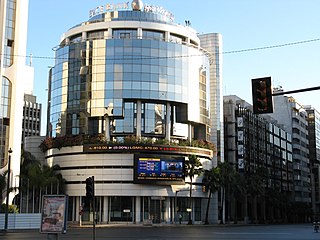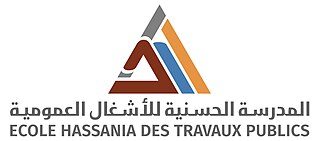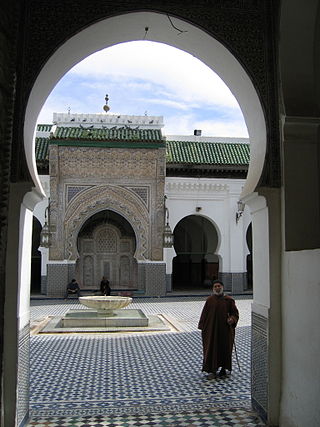
Casablanca is the largest city in Morocco and the country's economic and business centre. Located on the Atlantic coast of the Chaouia plain in the central-western part of Morocco, the city has a population of about 3.22 million in the urban area, and over 4.27 million in Greater Casablanca, making it the most populous city in the Maghreb region, and the eighth-largest in the Arab world.

The ONA Group is a defunct Moroccan holding company established in 1934 and dissolved in 2010 and succeeded by Societe Nationale d'Investissement. ONA was an industrial, financial and services conglomerate, focused on positions of leadership and value creation in business activities contributing to the growth and sustainable development of Morocco, the Maghreb Region and the African Continent. ONA Group was structured around several activities: Mining, Agribusiness, Distribution, Financial Services, Telecommunication, Renewable Energies, and Growth Drivers, etc.

Maroc Telecom is the main telecommunications company in Morocco. Currently employing around 11,178 employees, it is the largest telecommunications network in the country with 8 regional delegations and 220 offices present across Morocco. The company is listed on both the Casablanca Stock Exchange and Euronext Paris.

Attijariwafa bank is an international financial services group headquartered in Casablanca, Morocco. Since its formation in 2004 by merger between Banque Commerciale du Maroc and Wafabank, it has been the leading bank in Morocco and kept that rank as of 2024. It is listed on the Casablanca Stock Exchange.

Banque Commerciale du Maroc was a bank founded in 1911, shortly ahead of the establishment of the French protectorate in Morocco. The bank was initially controlled by France's Banque Transatlantique, then from 1941 by the Crédit Industriel et Commercial, and from 1988 by Morocco's ONA Group. In 2004, it merged with Wafa bank to form Attijariwafa Bank.

The Banque Marocaine pour le Commerce et l'Industrie is a bank in Morocco, headquartered in Casablanca. It is majority-owned subsidiary of Paris-based BNP Paribas (BNPP), and originates from the Moroccan operations of a predecessor of BNPP, the Banque Nationale pour le Commerce et l'Industrie (BNCI).
BCP Group, also referred to as Crédit Populaire du Maroc and popularly known under the brand Banque Populaire or Chaabi, is a major financial services group in Morocco, headquartered in Casablanca. The acronym BCP stands for the group's central entity, the Banque Centrale Populaire which also operates retail services in the region of Casablanca and El Jadida. The group also comprises eight regional entities known as Banques Populaires Régionales: these are, respectively, Centre-Sud, Fez-Meknes, Laayoune, Marrakesh-Beni Mellal, Nador-Al Hoceima, Oujda, Rabat-Kenitra, and Tangier-Tétouan.

Bank of Africa (BOA) is an international financial services group headquartered in Casablanca, Morocco. It was formed through the 2010 acquisition of Bank of Africa by the Banque Marocaine du Commerce Extérieur, following which BMCE rebranded its commercial operations as Bank of Africa in 2020. The BMCE name survives in the byline "BMCE Group" incorporated in the BOA brand identity.

The Hassania School of Public Works, is one of Morocco's oldest engineering schools, a member of the Conférence des grandes écoles, and remains to this day the most prestigious Moroccan Grande Ecole in engineering. It is located in Casablanca few miles from the Casablanca Technopark.

Science and technology in Morocco has significantly developed in recent years. The Moroccan government has been implementing reforms to encourage scientific research in the Kingdom. While research has yet to acquire the status of a national priority in Morocco, the country does have major assets that could transform its R&D sector into a key vehicle for development. The industry remains dominated by the public sector, with the universities employing 58% of researchers. Morocco's own evaluation of its national research system – carried out in 2003 – revealed that the country has a good supply of well trained high quality human resources and that some laboratories are of very high quality. However, the greatest gap at that point of time lied in the link between research and innovation. The educational qualifications of Moroccan researchers have increased significantly since the early 1990s. The University of Al-Karaouine is considered the oldest continuously operating academic degree-granting university in the world.

Water supply and sanitation in Morocco is provided by a wide array of utilities. They range from private companies in the largest city, Casablanca, the capital, Rabat, Tangier, and Tetouan, to public municipal utilities in 13 other cities, as well as a national electricity and water company (ONEE). The latter is in charge of bulk water supply to the aforementioned utilities, water distribution in about 500 small towns, as well as sewerage and wastewater treatment in 60 of these towns.
Inwi is a telecommunications company in Morocco. One of the three major Internet service providers in the country, it is a subsidiary of the group SNI and the Kuwaiti group Zain.
SOMED is a conglomerate company based in Morocco. It is active in a range of sectors such as mining, construction material dealership, tourism, real estate development, food processing and Car dealership. Its capital is composed of Mohammed VI's holding company SNI, Emirati private funds and the Moroccan state.

Casablanca Finance City (CFC) is an economic and financial center located in Casablanca, Morocco. Its goal is to act as a bridge between north and south by attracting international institutions and investors to invest and operate in North, West, and Central Africa, with Casablanca serving as the gateway to the region. The center focuses on three business categories: financial companies, professional services providers, and regional or international headquarters of multinationals.
The following is a timeline of the history of the city of Casablanca, Morocco.

Kamal Mokdad is a Moroccan banker who is the general manager of Banque Centrale Populaire of Morocco. He is also the head of International Global Banking and the chief executive officer of BCP Consulting.

La Compagnie Marocaine was a French colonial holding company founded in 1902 for the purpose of exploiting Morocco.

The State Bank of Morocco was a quasi-central bank established in 1907 following the Algeciras Conference, to stabilize the Moroccan currency and serve as a vehicle for European and especially French influence in the Sultanate of Morocco. Following the independence of Morocco, it was replaced in 1959 by the newly created Banque du Maroc, known since 1987 as Bank Al-Maghrib.

Société Générale Morocco, formal name the Société Générale Marocaine de Banques since 1965 (SGMB), is the Moroccan subsidiary of Société Générale, headquartered in Casablanca and originally established in 1913. In April 2024, Société Générale announced the sale of its majority stake in SGMB to the Saham Group controlled by Moroccan financier Moulay Hafid Elalamy.














